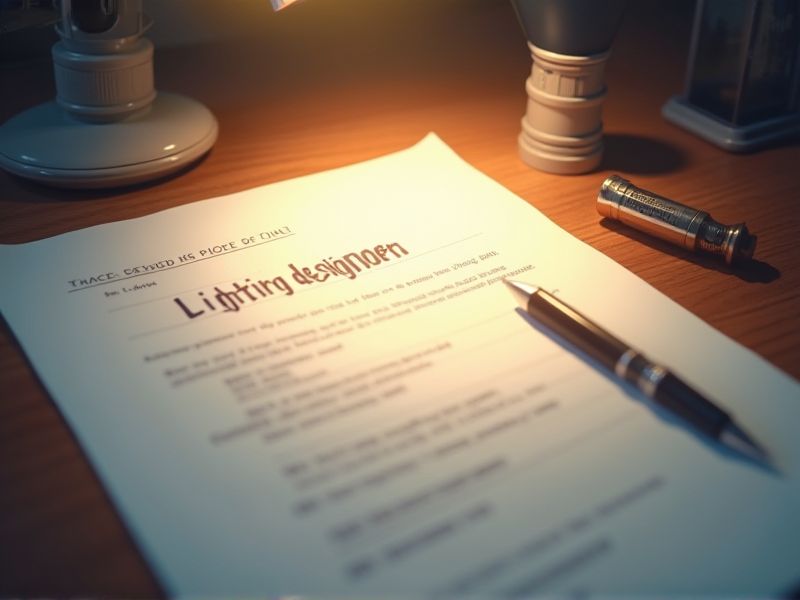
Lighting designers play a crucial role in creating environments that balance aesthetics, safety, and functionality. Certain certifications ensure they possess a comprehensive understanding of lighting technology, sustainable practices, and safety standards. Certification validates a designer's expertise and can significantly enhance professional credibility and career opportunities. Below are essential certifications that may be required for a lighting designer.
Lighting Certified (LC) - NCQLP
Lighting designers benefit from Lighting Certified (LC) - NCQLP as it validates their expertise and knowledge in the field, leading to increased credibility with clients and employers. The certification ensures designers are up-to-date with industry standards and best practices, which is crucial in an ever-evolving field. Professional certification often leads to better job opportunities and higher earning potential, as it distinguishes certified individuals from their peers. Obtaining LC certification demonstrates a commitment to continued professional development and dedication to quality lighting design.
Certified Lighting Designer (CLD)
A Certified Lighting Designer (CLD) ensures adherence to best practices and industry standards, enhancing project outcomes. The certification demonstrates a designer's proven expertise and credibility, attracting more clients. CLD holders often bring innovative solutions due to their in-depth knowledge, leading to more efficient and sustainable designs. By having a CLD, a lighting designer gains a competitive edge in a field that values specialized skills.
IES Professional Certification in Lighting Design
Obtaining the IES Professional Certification in Lighting Design provides a standardized validation of a lighting designer's expertise and skills, which can enhance credibility in a competitive industry. With recognized certification, lighting designers are more likely to gain access to advanced projects due to increased trust from clients and employers. Certification requires keeping up with the latest industry standards and technological advancements, ensuring designers remain informed and competent. This professional edge often leads to career advancement opportunities and potentially higher income.
LEED Accredited Professional (LEED AP)
LEED AP certification equips lighting designers with expertise in green building principles, enhancing their ability to integrate sustainable lighting solutions. By understanding LEED criteria, designers can contribute to achieving certification points for projects, increasing a building's environmental performance. This accreditation also strengthens their marketability, with clients increasingly prioritizing sustainable practices. A LEED AP designation can facilitate collaboration with interdisciplinary teams focused on energy-efficient and sustainable designs.
WELL Accredited Professional (WELL AP)
The WELL Accredited Professional (WELL AP) credential validates a lighting designer's expertise in human health and well-being in built environments. It ensures that lighting designs meet rigorous standards that can enhance occupants' comfort, mood, and productivity. Possessing the WELL AP credential can differentiate a lighting designer in a competitive market by showcasing their commitment to sustainable and health-focused design practices. Given the growing emphasis on wellness in architecture, having a WELL AP can offer opportunities to engage in projects that prioritize human-centric design approaches.
NICET Certification in Lighting Systems
NICET Certification in Lighting Systems enhances a lighting designer's credibility, demonstrating a validated proficiency in technical knowledge and industry standards. The certification often results in heightened trust from clients and employers, which can lead to more career opportunities and project responsibilities. Rigorous certification processes ensure that lighting designers keep up-to-date with evolving technologies and safety regulations. This commitment to continued education and professional growth often translates to improved design outcomes and client satisfaction.
Certified Energy Manager (CEM)
Hiring a Certified Energy Manager (CEM) optimizes energy efficiency in lighting designs, which leads to reduced operational costs. With specialized knowledge in energy systems, a CEM ensures that lighting designs comply with regulatory standards, thereby preventing potential legal issues. Their expertise in performance metrics enhances lighting quality, contributing to improved occupant satisfaction and productivity. The integration of a CEM in lighting projects supports sustainability goals, aligning with broader environmental initiatives.
BREEAM Accredited Professional (BREEAM AP)
The presence of a BREEAM Accredited Professional (BREEAM AP) in a lighting design project ensures the integration of sustainability considerations, leading to reduced environmental impact. Lighting designers with BREEAM AP expertise can enhance energy efficiency, optimizing the use of natural light and advanced technologies. Early involvement of a BREEAM AP can facilitate smoother certification processes, aligning the project with BREEAM standards from the start. Projects guided by BREEAM-accredited professionals often see improved economic performance due to reduced operational costs.
Autodesk Certified Professional: Revit for Lighting Design
The Autodesk Certified Professional: Revit for Lighting Design validates a designer's expertise in using Revit, a crucial software for creating precise lighting designs. Certification enhances a designer's credibility, making them more competitive in the job market. Mastery of Revit allows for efficient collaboration with architects and engineers, which increases project efficiency and reduces errors. Certified professionals often experience increased job opportunities and career advancement because they are proven to produce high-quality work.
DesignLights Consortium (DLC) Certification
DLC Certification ensures that lighting products meet specific performance standards, increasing energy efficiency and reducing operational costs. It provides third-party validation, which enhances credibility and trust with clients, encouraging their adoption of recommended lighting solutions. Compliance with DLC standards often qualifies products for utility rebates, further incentivizing their selection in projects. It aids designers in making informed decisions, fostering sustainability and promoting industry best practices.
Summary
You, as a lighting designer, can expect enhanced credibility and trust within the industry upon obtaining certifications. This recognition often leads to increased job opportunities and the potential for higher salary offerings. Certified individuals frequently experience a boost in skills, staying updated with the latest lighting technologies and sustainable practices. Employers typically view certified designers as more committed and knowledgeable, resulting in career advancement and leadership roles.
